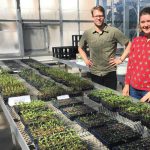BioCycle May/June 2019
“New & Improved”: K-12 Schools Food Recovery Roadmap
About a year ago, BioCycle collaborated with Nancy Deming of the Oakland (CA) Unified School District (USD) and Janet Whited of the San Diego USD to create a K-12 Food Recovery Roadmap that detailed Deming’s and Whited’s journeys to implementing surplus food reduction and recovery programs at their K-12 school districts. Shortly after the Roadmap was published, the U.S. Green Building Council (USGBC) approached Deming about making the Roadmap an interactive linked webpage through the support of the USGBC Center for Green Schools. This new and improved K-12 Schools Roadmap for Reduction and Recovery is now live. “Much thanks to the dedicated collaboration with Janet Whited, Nora Goldstein and U.S. Green Building Council,” said Deming when announcing the new interactive version in late April.
State Food Waste Legislation Roundup
Three state legislatures — New York, Maryland and Washington — acted this spring to pass bills that encourage food waste reduction and recycling:
New York State’s Food Scraps Recycling Act includes the following:
• All “Designated food scraps generators” (DFSG) — “who generate at a single location an annual average of 2 tons/week or more of food scraps” based on a methodology established by state’s Departmen of Environmental Conservation (DEC) regulations — shall separate their excess edible food for donation for human consumption to the maximum extent practicable effective Jan. 1, 2022.
• DFSGs include supermarkets, large food service businesses, higher educational institutions, hotels, food processors, correctional facilities, and sports or entertainment venues. DFSGs can apply for one-year waivers.
• “Food scraps” are defined as inedible food, trimmings from the preparation of food, food-soiled paper, and edible food that is not donated.
• Each DFSG within 25 miles of an organics recycler (and if the recycler is determined by DEC to have capacity to accept DFSG’s food scraps) shall separate its remaining food scraps from other solid waste, ensure proper storage on site to preclude odors and vectors; and have information available and provide employee training for separation storage.
Washington State’s Food Waste Reduction (E2SHB 1114) establishes goal of 50 percent food waste reduction by 2030. Plan must include strategies to “…support productive uses of inedible food materials,” e.g., composting, vermicomposting, anaerobic digestion for energy production. Plan must also “…recommend a funding environment in which stable, predictable resources are provided to wasted food prevention and rescue and food waste recovery activities in such a way as to allow the development of additional capacity and the use of new technologies.”
Maryland’s HB510 prohibits an owner or operator of a refuse disposal system from accepting loads of separately collected food waste for final disposal unless the owner or operator provides for the “organics recycling” of the food waste. “Organics recycling” includes anaerobic digestion and composting. However, if an organics recycling facility determines the separately collected food waste is unacceptable for recycling due to contamination, the food waste may be accepted by a refuse disposal system for final disposal.
Vermont Food Scraps Stats
The Vermont Department of Environmental Conservation (DEC) released its biennial report on solid waste, and its Universal Recycling Law Status Report in January 2019. The biennial report noted that Vermont’s most recent draft 2018 Waste Composition study shows a similar percentage of food waste in the waste stream compared with the 2013 study. “This reinforces Agency of Natural Resources’ support for maintaining the July 1, 2020 [disposal] ban on food scraps in order to meet long-standing state diversion goals,” wrote DEC officials. “Further, the premise behind the Universal Recycling law’s food scraps disposal ban is to provide assurance to those who are willing to invest, that food and food scrap material will be available for processing.”
The Status Report provides the following 2017 statistics:
• Currently, 12 certified food scrap processing facilities (composting & anaerobic digestion) operate year-round in Vermont. In 2017, VT composting facilities received more food scraps than previous years— a 9% increase from 2016.
• Over 100 transfer stations now provide food scrap drop-off for customers.
• Food rescue nearly tripled from 2014-2017, according to the Vermont Foodbank.
• Vermont has 17 farm digesters; some accept food-processing by-products from dairy, brewing, and other food manufacturing to produce electricity and heat.
• About 80% of towns have commercial food scrap hauling and some have residential.
Plant Based Products Council
The Plant Based Products Council (PBPC) was launched by a group of businesses and environmental leaders in January to promote the adoption and use of products derived from renewable biomass. The group will advocate for private sector programs and government policies to reduce carbon emissions, improve water quality and soil health, and curtail solid waste destined for landfills by purposeful closed loop end-of-life strategies through recycling and composting. PBPC’s membership includes large and small businesses from across the U.S. that produce, distribute, or sell products/packaging from renewable biomass inputs, as well as organizations that have made related public commitments to build a more sustainable future.
Polling, conducted in August 2018 and recently released by the PBPC, reinforces the notion that millennial consumers are supportive of bioplastics and even willing to pay more for them. Findings include:
• 48% of millennials feel most guilty about their own plastic use compared to other resources, such as paper (33%), water (31%) or the amount they drive (19%).
• 64% of millennials are willing to use alternatives to plastic.
• 60% of millennials surprised by the lack of alternative options to plastic.
• While only 13% are “very familiar” with bioplastic, once described, 90% become favorable to bioplastics










